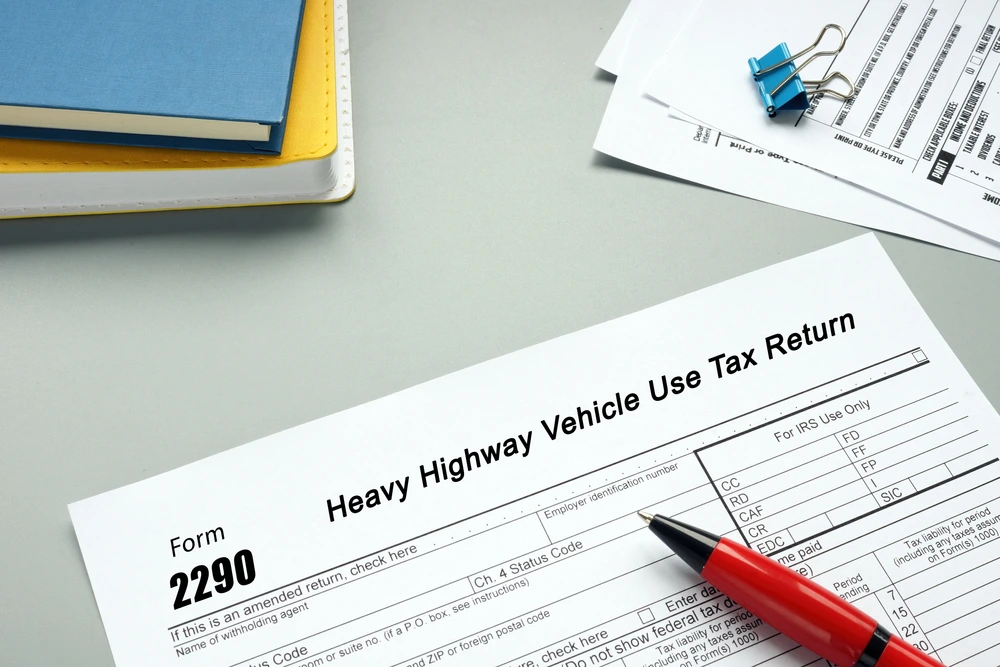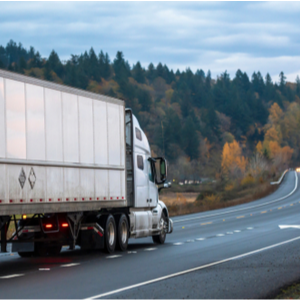
If you operate a heavy vehicle on public highways in the United States, you’re likely required to file IRS Form 2290 and make the corresponding IRS 2290 payment. This form is part of the Heavy Vehicle Use Tax (HVUT) program, a federal excise tax imposed on vehicles with a taxable gross weight of 55,000 pounds or more.
The purpose of this tax is to help fund the maintenance and repair of America’s highways — roads that heavy trucks significantly impact due to their weight. The IRS uses the information from Form 2290 to assess how much tax is owed for each qualifying vehicle. In exchange, once the form is filed and payment is accepted, you receive a stamped Schedule 1, which serves as your official proof of HVUT payment. This Schedule 1 is required for important processes such as vehicle registration, license plate renewal, or interstate travel permits.
Whether you’re an owner-operator, fleet manager, or tax professional, understanding the IRS 2290 payment process is critical for staying compliant, avoiding penalties, and ensuring your vehicles stay road-legal. In this article, we’ll break down everything you need to know—from payment methods and deadlines to how to handle rejections or request tax credits.
What Is the IRS 2290 Payment?
The IRS 2290 payment is the Heavy Vehicle Use Tax (HVUT) that must be paid annually to the Internal Revenue Service (IRS) by individuals or businesses that operate heavy vehicles on public highways. This payment accompanies the filing of IRS Form 2290, which reports each qualifying vehicle and calculates the tax due based on weight and usage.
Definition of IRS 2290 Payment
The IRS 2290 payment is a federal excise tax owed by truck owners for using the U.S. highway system with vehicles that meet specific weight and usage criteria. Once paid, the IRS issues a Schedule 1 as proof of payment. This stamped Schedule 1 is required by most state Departments of Motor Vehicles (DMVs) for vehicle registration or plate renewal.
The amount of tax due depends on several factors, including:
- The vehicle’s taxable gross weight
- Whether the vehicle is used for logging
- The number of months the vehicle is in use during the tax year
Vehicles Subject to the Tax (55,000 lbs+ Gross Weight)
Not all vehicles are subject to the HVUT. The IRS requires payment only for vehicles with a taxable gross weight of 55,000 pounds or more. This typically includes:
- Semi-trucks and trailers
- Commercial buses
- Construction vehicles
- Other heavy-duty vehicles used on public highways
Exemptions may apply for:
- Government-owned vehicles
- Indian tribal government vehicles used for essential services
- Certain blood-collection vehicles
- Qualified agricultural vehicles used less than 7,500 miles annually
However, even exempt vehicles must still file Form 2290 to report their exempt status.
Annual Tax Year: July 1 to June 30
The IRS 2290 tax follows a federal tax period, not a calendar year. The HVUT tax year runs from July 1 to June 30 of the following year.
For example:
- The 2025–2026 tax year starts on July 1, 2025, and ends on June 30, 2026.
- The deadline for filing and paying for most vehicles in service by July 1 is August 31, 2025.
For vehicles put into service after July, the payment is prorated based on the month of first use.
When and Why It Must Be Paid
The IRS 2290 payment is due annually and must be paid by August 31 for most vehicles in service at the beginning of the tax year. If a vehicle is first used on public highways during any other month, the filer has until the last day of the following month to file and pay.
Failure to file and pay on time can result in:
- IRS penalties and interest
- Delays in vehicle registration or tag renewal
- Potential issues with compliance audits
By paying the IRS 2290 on time and keeping your Schedule 1 current, you ensure that your heavy vehicles remain compliant, registered, and road-ready.
IRS 2290 Payment Deadlines
Understanding the deadlines associated with the IRS 2290 payment is critical to staying compliant with federal tax regulations and avoiding penalties that can delay vehicle registration or operation. The IRS has clearly defined timelines for both annual filings and pro-rated filings depending on when the vehicle is first placed into service.
Annual Deadline: August 31
For most truck owners and operators, the IRS 2290 tax year begins on July 1 and ends on June 30 of the following year. If your heavy vehicle is in use on public highways in July, the deadline to file Form 2290 and make the IRS 2290 payment is August 31 of that same year.
For example:
- If your truck was in use as of July 1, 2025, the deadline to file Form 2290 for the 2025–2026 tax year is August 31, 2025.
Meeting this annual deadline ensures your Schedule 1 is processed in time for tag renewals, registration, and continued legal operation on U.S. highways.
Pro-Rated Filing Rules for Newly Registered Vehicles
If a vehicle is first placed into service after July, the IRS allows you to file on a pro-rated basis. This means you only pay tax for the months remaining in the tax year—not the entire 12-month period.
Key points to remember:
- The tax is calculated based on the first month the vehicle is used on public highways.
- The IRS 2290 must be filed by the last day of the month following the month of first use.
Example:
- If you purchase and begin using a truck in November 2025, your Form 2290 and IRS 2290 payment would be due by December 31, 2025.
- Your Schedule 1 for that vehicle will reflect the start month and be valid through June 30, 2026.
Pro-rated filings are common for new vehicle purchases, leased vehicles, or equipment put into service mid-year.
Penalties for Late Payment
Missing your IRS 2290 filing or payment deadline can result in costly penalties and interest charges. These penalties can quickly add up and may even impact your ability to register or operate your vehicle legally.
Late payment consequences include:
- Penalty of 4.5% of the total tax due, assessed monthly for up to 5 months
- Additional interest of 0.54% per month on unpaid taxes
- Possible suspension of vehicle registration by your state DMV
Filing even one day late can trigger these penalties, so it’s crucial to file on time—even if you cannot pay the full amount immediately. Filing on time but arranging for a delayed payment (e.g., through EFTPS or a payment plan) may help reduce penalties.
Avoiding Deadline Issues
To stay ahead:
- Mark your calendar for the August 31 annual deadline.
- Use e-filing services like ExpressTruckTax to get instant confirmation and your stamped Schedule 1 within minutes.
- Sign up for email or SMS reminders so you never miss your IRS 2290 due date.
How to Make an IRS 2290 Payment
Paying your IRS 2290 Heavy Vehicle Use Tax doesn’t have to be complicated or time-consuming. With several secure payment methods and online filing options available, you can complete the process quickly and receive your official proof of payment — Schedule 1 — often within minutes. Here’s how to do it the right way.
Choosing Your Payment Method
Before you file Form 2290, you’ll need to decide how you want to pay the IRS. There are four accepted payment methods:
- Electronic Funds Withdrawal (EFW)
- Direct debit from your bank account during the e-filing process.
- Requires routing and account number.
- EFTPS (Electronic Federal Tax Payment System)
- A free IRS system where you schedule your payment separately at EFTPS.gov.
- Requires prior enrollment.
- Credit or Debit Card
- Pay through an IRS-approved third-party processor.
- May include processing fees (typically 1.87%–2.35%).
- Check or Money Order
- Mailed with a Form 2290-V payment voucher if you’re paper-filing (not recommended for speed or accuracy).
- Slower processing and no instant Schedule 1.
Tip: The fastest way to pay and receive your Schedule 1 is to file Form 2290 electronically and pay via EFW or EFTPS.
Step-by-Step Guide to IRS 2290 Payment Process
Here’s a simplified step-by-step breakdown to guide you through the IRS 2290 filing and payment process:
- Gather your information:
- EIN (Employer Identification Number)
- Business name and address
- Vehicle details (VIN, weight category, first-used month)
- Payment method (bank info or credit card, if applicable)
- File IRS Form 2290:
- Either electronically (recommended) or by paper mail (slowest option).
- For 25 or more vehicles, e-filing is required by law.
- Select your payment method:
- Choose EFW, EFTPS, credit/debit card, or check/money order.
- If using EFTPS or card, you must submit the payment separately.
- Transmit the return to the IRS:
- Submit your Form 2290 electronically through a trusted provider like ExpressTruckTax.
- Submit your Form 2290 electronically through a trusted provider like ExpressTruckTax.
- Receive your stamped Schedule 1:
- If accepted, the IRS sends your Schedule 1 via email or in your dashboard within minutes.
Filing Form 2290 Online via ExpressTruckTax
ExpressTruckTax is the #1 IRS-authorized e-file provider for Form 2290 and offers the fastest, most reliable way to complete your IRS 2290 payment. Here’s how it works:
- Create an account (or log in if you’re a returning user).
- Enter business and vehicle details — or use the Ready Return feature to copy data from a prior year.
- Select your IRS 2290 payment method and enter your payment details.
- Review and transmit your return to the IRS.
- Receive your Schedule 1 instantly via email, dashboard download, or fax.
With features like free VIN correction, real-time IRS status tracking, and bilingual U.S.-based support, ExpressTruckTax makes the process faster, easier, and more accurate — all backed by their Guaranteed Schedule 1 or your money back promise.
How Schedule 1 Is Generated After Payment
Once your IRS 2290 payment is processed and accepted, the IRS issues Form 2290 Schedule 1, which serves as your official proof of payment.
Here’s what happens:
- The IRS digitally stamps your Schedule 1 with a watermark and received date.
- This document is returned to you via:
- Download from your account
- Optional fax or text alert
- Schedule 1 is then used for:
- Vehicle registration or renewal at your local DMV
- Tag renewal
- DOT compliance verification
Pro Tip: Save a digital and printed copy of your Schedule 1 in your records — it’s required for road compliance and audits.
Ensure Your Fleet Stays Compliant and Road-ready with ExpressTruckTax!
Filing your IRS Form 2290 doesn’t have to be complicated or time-consuming. Leverage the industry’s leading HVUT e-filing solution—ExpressTruckTax—to easily submit your Form 2290 online, receive your stamped Schedule 1 in minutes, and keep your vehicles operating without interruption or penalties.





